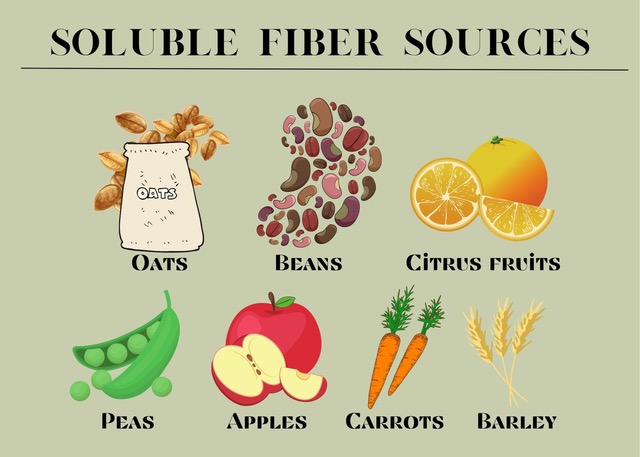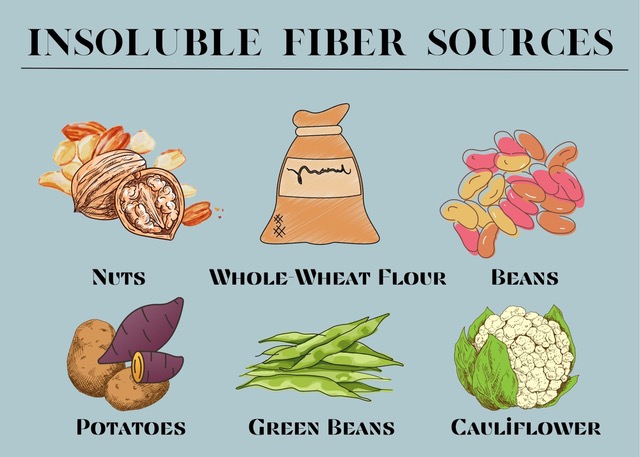“Too Much Fiber or Too Little? Know the Signs” was written by Amy Puccini. Edited/reviewed by Katie Dodd, MS, RDN, CSG, LD, FAND. Amy is a dietetic intern at Oregon Health Sciences University.
Eat Your Fiber!
We’ve probably all been told to eat more fiber at some point in our lives, but is it possible to eat too much fiber?
Yes! Although fiber is an extremely important component of a healthy diet, eating too much can cause temporary discomfort. From bloating to gas to cramps, things can get uncomfortable.
In this article we’ll explore the basics of fiber, how much we should be eating, signs that we may be eating too much, and what happens when we don’t eat enough.
Fiber 101
Before we dive in, let’s cover the basics.
The Basics
Let’s back up and start from the beginning. Dietary fiber comes from our food, plants to be more specific. It is associated with many, many health benefits. For example, maintaining a healthy weight, good digestion, and heart health.
Fiber is a carbohydrate. It is a nutrient that our bodies can’t break down through digestion. This means what goes into the body also comes out of the body. Good sources include fruits, vegetables, nuts, seeds, legumes, and whole grains.
There are two types of fiber, soluble and insoluble, each with a unique role.
Soluble Fiber
Soluble fiber breaks down in water creating a gel-like substance that slows digestion and helps you feel full. Good sources include oats, barley, beans, peas, carrots, apples, and citrus fruits.
This type is also known for lowering cholesterol.

Insoluble Fiber
Insoluble fiber stays intact and adds bulk to our stools, decreasing the amount of time it takes to travel through our intestines. This type can be found in whole-wheat flour, nuts, beans, and vegetables such as potatoes, green beans, and cauliflower.
This type is known for preventing constipation.

The Health Benefits
Both types are important for a healthy digestive system but have far-reaching effects throughout the entire body.
Here is a list of health benefits:
Maintain Normal Bowel Movements
Since fiber isn’t fully digested it adds bulk to your stool. This makes it easier to pass and reduces the risk of constipation. It is important to drink adequate fluid and be physically active to keep the bowels healthy.
In addition to helping to prevent constipation, it can also prevent diarrhea. You can also use foods like banana flakes to help solidify any loose or watery stools.
Protective Against Colon Cancer
The most effective way to reduce your risk of colon cancer is to get regularly screened starting at the age of 45 (or earlier if your family has a history of developing colon cancer earlier than the age of 45).
However, promising research has indicated that individuals who have higher intakes of fiber have a lower chance of developing colon cancer.
Soluble fiber is the star of the show when it comes to lowering cholesterol. This type, found in oats and beans, can help by lowering the “bad” type of cholesterol also known as low-density lipoprotein or LDL. This is good news for keeping the heart healthy.
Control Blood Sugar Levels
As previously discussed, soluble fiber turns into a gel-like substance which can help to slow the absorption of nutrients. This includes sugar or carbohydrates. Which is useful in controlling blood sugar levels in individuals with diabetes.
A high fiber diet may also be beneficial in lowering your chance of developing type 2 diabetes.
Achieve and Maintain a Healthy Weight
Eating a diet high in fiber can help you feel fuller quicker and for a longer period of time. This means you feel satisfied after eating and are less likely to overeat. It will also take longer before you get hungry again.
High fiber foods are generally lower in calories than their counterparts (think fruits and vegetables!). They also typically take longer to chew, which can aid in digestion and allow your body time to recognize it’s getting full.
Phew! Clearly, we can see there are a ton of positive benefits. Which begs the question, exactly how much should I be eating?
Recommended Daily Goals
The amount you need depends on your gender, age, and if you have any gastrointestinal issues, such as Crohn’s disease.
The following table includes the general recommendations of daily fiber for adults:
| Age: 18-50 | Age: 50+ | |
| Men: | 38 grams | 30 grams |
| Women: | 25 grams | 21 grams |
Tips for Increasing Fiber Intake
Ready to take advantage of all these health benefits but don’t know where to start? Here are a few tips to get you started:
- Easy breakfast hack – Try a high-fiber cereal with 5 or more grams per serving. Add some fresh fruit for an extra boost.
- More whole grains – Dietary recommendations include making up half of your grains as whole grains. Try swapping your regular spaghetti for a whole grain version and brown rice instead of white rice.
- “Beans, beans, the magical fruit” – These babies are jam packed with both types of fiber, they really are magic! Nothing warms me up on a cold day like a warm cup of vegetarian chili. You can also sneak beans into a ready-made soup, blend them into a tasty dip, or add them on top of a salad. Check out these easy recipes here!
- Fruits and vegetables – Sneaking more fruits and vegetables into your diet has many health benefits. You’ll also get a punch of vitamins and minerals. Aim for 5 or more servings of fruits and vegetables a day. Try to add a good source at every meal.

Fiber Statistics
Although you may be here because you’re wondering if you are eating too much fiber, it’s estimated that only 5% of Americans are not eating enough (i.e. they aren’t eating the recommended daily amounts).
So, who is at risk for eating too much fiber?
Typically, it is any person following currently following a plant-based, whole food, vegan, or raw diet. These eating patterns certainly aren’t bad, they are just higher in fiber and can lead to discomfort. Especially if you increase the amount of fiber in your diet rapidly.

Too Much of a Good Thing
Common signs and symptoms associated with consuming too much fiber include:
- Bloating
- Constipation
- Cramping
- Diarrhea
- Early satiety (feeling fuller faster)
- Gas
- Nausea
- Vomiting
- High fever
- Inability to pass gas or stool for more than a few days
If you have concerns about the symptoms you are experiencing, seek medical attention immediately:
Relief From GI Discomfort
If you or your loved ones are experiencing symptoms related to eating too much fiber, here are a few tips to help:
Drink more water
Fiber and water go together like peanut butter & jelly! Drinking more water can help alleviate many of the signs and symptoms associated with consuming too much.
Reduce the amount of fiber in your diet
If drinking more water doesn’t help, try reducing the overall amount of fiber in your diet. Once you start to feel normal again, slowly increase until you’re back to your recommended daily goal.
Avoid foods that contribute to bloating
Different foods can trigger bloating, so be mindful of which foods affect you. Chewing gum and carbonated beverages can also contribute to bloating.
Increase exercise
Go for a quick walk, try some yoga, or dance around in your living room. Increasing your movement can help keep things moving along and rid your body of excess gas which may be contributing to discomfort.
Talk to your healthcare provider
If you are still experiencing uncomfortable GI symptoms, consider talking to your doctor or a registered dietitian nutritionist.
Here are a few questions you can consider asking:
- Could my symptoms be related to my fiber intake?
- How do I increase my fiber intake slowly?
- Should I be taking a supplement?

Overview
It’s clear to see that fiber is an important part of our diet and can make a big impact on our health. The benefits of including a wide variety of these foods far outweigh the potential discomfort of consuming too much.
However, symptoms of eating too much fiber can occur when we over-consume or increase our intake too quickly.
The good news, this too shall pass! Discomfort associated with an increase in fiber intake will pass with time. If it doesn’t, consider talking to your doctor about your symptoms.
Make it your to reach your daily recommended fiber target. But don’t forget to increase your water intake along with it! Aim for 8+ glasses of water each day.

Thanks so much. Article fantastic. I learned a great deal. M
I’m so glad!
Fiber is such an essential part of one’s nutrition that it’s easy to forget that it can be a negative in certain circumstances. Great insight here!
Right?! Thanks for sharing.